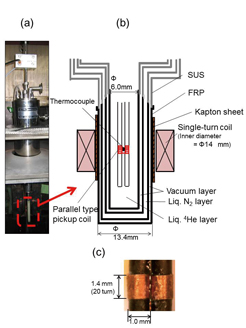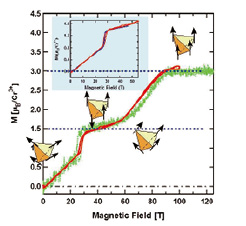Ultra-High Magnetic Field Precision Magnetization in the Vertical Single-Turn Coil System
Takeyama, Y. Matsuda, and Tokunaga Groups
Magnetization is one of the most important measurements for understanding electro-magnetic properties of materials. Utilizing time variation of the magnetic flux inherent to a pulse magnet, the electromagnetic induction method is mostly used as a tool for a sensitive magnetization measurement in a variety of magnetic materials. In recent years, there occurred high demands for magnetization measurements in very high magnetic fields. On the other hand, a magnetic field above 100 T is only generated in a destructive manner, i.e., by destroying the magnet. The single-turn coil (STC) technique is very useful for solid-state physics measurements in a range of ultra-high magnetic fields of up to 300 T, since the coil only explodes outwards, while the sample and the equipment that holds it are usually kept intact inside the exploding coil, and both the elevating and descending of the magnetic field is utilized in a one-shot measurement. A peak field of up to 200 T can be generated in a 10-mm bore of the coil by an injection of mega-ampere from 200 kJ fast operating capacitor banks installed at the International MegaGauss Science Laboratory ISSP [1].

Fig. 1. (a) Photo picture of the cryogenic container developed for the vertical-STC, and (b) cross-sectional diagram of the tail section with (c) a photo picture of the self-compensated magnetic pickup coils.

Fig. 2. The magnetization data measured up to 103 T at 4.2 K with elevating and descending magnetic field (red lines), together with the data taken from the Faraday rotation previously measured at 7 K (green plots) [5]. Spin moment configuration in each magnetic phase is shown. The inset is the comparison with those taken by a non-destructive long pulse magnet measured at 4.2 K (blue lines).
First application of the pickup coil detection of the magnetization to the STC technique was conducted by S. Takeyama and K. Amaya, who obtained the magnetization curve of CsCoCl3 in magnetic fields up to 90 T at a temperature 4.2 K [2]. This direction of research has been continued, with further technical improvement achieved by T. Goto et al. to obtain a nice magnetization curve of a typical itinerant ferro-magnet YCo3 up to 110 T. At Humboldt University in Berlin, A. Kriste et al. have achieved compensation ratios of better than 10-3 in two alternatively wound parallel pickup coils. In addition, magnetization measurement in magnetic fields of up to 130 T was applied to bismuth-based manganites (Bi0.5 Ca 0.5MnO3, Bi0.5 Sr 0.5MnO3) in order to investigate the nature of the ferromagnetic phase in terms of its relevance to the charge order phase [3]. All of these, however, are such that the signal-to-noise ratio and the level of the background signal were insufficient to provide details of the absolute values of magnetization, M, in magnetic fields, and were only sufficient to determine the transition points of a magnetic field from dM/dt.
We have established a precision magnetization measurement system in a vertical-STC, with approaching comparable data quality obtained by the nondestructive long pulse magnet. Due to the deformation of the coil during the explosive outward movement of the magnet coil, the time dependences of the magnetic field distribution inside the coil were carefully examined, and the best position of the twin-parallel pick-coils were identified. Schematics of the magnetic probe and its component are presented in Fig.1. The magnetic pickup coils are positioned precisely at the center of the single-turn coil. A cryostat was specifically designed for the V-STC system as shown in Fig.1 (a,b). The upper part of the cryostat is made of stainless steel, and is comprised of a liquid He container with a tail section made of glass epoxy (Fiber-Reinforced Plastic; FRP) thin tubes. The thickness of the tube walls is 0.7 mm for both the innermost and the outermost walls, and 0.5 mm for the other two walls. Thus, the spaces of the inner vacuum insulating layer, the liquid N2 layer, and the outer vacuum insulating layer are designed to be 0.3 mm, 0.5 mm and 0.5 mm, respectively. The FRP thin tubes are connected smoothly to the upper stainless steel tubes by a cryogenic epoxy adhesive (Nitofix, SK-229). Liquid He stored at the container of 0.3 ℓ was maintained for more than 3 hours.
Our new system has been applied to a geometrically frustrated magnets which have been one of an current issue of topics as its ground state are macroscopically degenerated and are vulnerable to small perturbations (spin-lattice interaction, quantum and thermal fluctuation, etc.). Application of magnetic field causes the appearance of peculiar magnetic phenomena such as the magnetization plateaus, magnetic supersolids and crystalline magnon states as a result of interplay between a magnetic field and frustrated spin exchange interaction. Among the numerous frustrated magnets, CdCr2O4 is recognized as one of the typical three-dimensional frustrated magnets exhibiting a very high Curie-Weiss temperature and a low Neel temperature (TN/ΘCW=8 K/70 K ~ 0.1 «1 ), which is caused by suppression of a magnetic order by the geometrical frustration, which requires multiple extreme physical conditions, such as ultra-high magnetic fields and very low temperatures, for thorough understanding of the magnetic orders. H. Ueda et al. reported magnetization of CdCr2O4 in magnetic fields up to 50 T using nondestructive long pulse magnets [4]. They found a first-order phase transition at 28 T followed by a wide magnetization plateau with a half-of-full moment (1/2 plateau). After this, H. Mitamura et al. have attempted measurements in magnetic fields up to 80 T by the induction method in the STC at 6 K. They could have shown a second order phase transition at 61 T and a first order phase transition at 77 T inferred only from data of the descending magnetic field of dM/dt. Signals from data of elevating magnetic field were difficult to analyze due to large ignition noises. Lately, Kojima et al. have applied a Faraday rotation method to this material for evaluation of magnetization [5]. They have carried out systematic measurements in wide temperatures in magnetic fields up to 140 T by the STC, and the magnetization processes until its full saturation moment are thoroughly revealed in wide range of temperature.
The results of the magnetization data measured up to 103 T with elevating and descending magnetic field are presented in Fig. 2 together with the data taken from the Faraday rotation previously measured at 7 K [5]. Both data coincide well with each other within the error of 3 % with respect to the full saturation moment. In the inset, the data is also compared with those measured by the long-pulse magnet in magnetic fields of up to 55 T. Owing to slow rate of the flux change subjected to the long-pulse magnet, a width of the hysteresis is almost invisible in this figure, but the transition occurred at a midpoint in magnetic fields between the hysteresis observed in the data taken by the present measurement. Striking coincidence is obtained in the two data. All the details are described in reference [6].
References
- [1] N. Miura, T. Osada, and S. Takeyama, J. Low Temp. Phys. 133, 139 (2003).
- [2] S. Takeyama et al., J. Phys. E 21, 1025 (1988); K. Amaya et al., Physica B155, 396 (1989).
- [3] A. Kirste et al., Phys. Rev. B 67, 134413 (2003).
- [4] H. Ueda et al., Phys. Rev. Lett. 94, 047202 (2005)
- [5] E. Kojima et al., Phys. Rev. B 77, 212408 (2008).
- [6] S. Takeyama, R. Sakakura, Y. H. Matsuda, A. Miyata, and M. Tokunaga, J. Phys. Soc. Jpn. 81, 014702 (2012).
